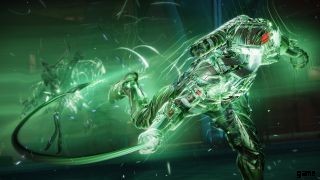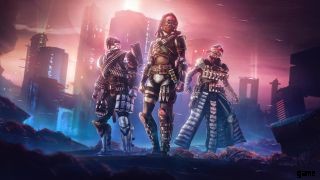
Der Destiny 2-Showcase letzte Woche hat eine Flut von Informationen über die nächste große Erweiterung fallen lassen:Lightfall. Es soll am 28. Februar landen und sieht die Wächter nach Neptun und der zuvor unentdeckten, glänzenden Stadt Neomuna reisen. Dort treffen sie auf neue Verbündete namens Cloud Striders, lernen, wie man Strand (eine zweite Unterklasse von „Darkness“) führt, und treten gegen Imperator Calus an, dessen Schattenlegion durch The Witness erweitert wurde und jetzt monströse „Peiniger“ enthält.
Selbst für engagierte Destiny 2-Fans war es ein viel . Und das war, bevor Sie sich mit den systemischen Änderungen befassten, wie dem Hinzufügen eines vielgewünschten LFG im Spiel, um bei der Suche nach Einsatztrupps für jede Aktivität zu helfen, dem noch stärker nachgefragten Ausrüstungsmanager und Verbesserungen an der häufig geschmähten Onboarding-Erfahrung für neue Spieler. Bei so vielen Fäden wollte ich sofort mit Game Director Joe Blackburn sprechen. Zu ihm gesellte sich der stellvertretende General Manager Dan McAuliffe, und wir begannen mit Strand.
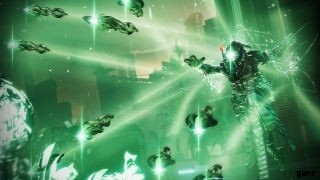
Ringkampf mit Strand
Die ursprünglichen „Licht“-Unterklassen von Destiny 2 haben relativ offensichtliche Themen in Bezug auf Feuer, Elektrizität und, ähm, das unendliche Nichts, das uns alle verfolgt. Im Jahr 2020 fügte Bungie die erste „Darkness“-Unterklasse in der eisigen Form von Stasis hinzu, aber Strand scheint das bisher esoterischste Unterklassenangebot zu sein. Die Tonhöhe ist, dass Sie in das Gewebe des Universums selbst greifen, um an den Fäden von Leben und Tod zu ziehen. In Bezug auf das Gameplay bedeutet dies, dass Hunter Threadrunners einen Seilpfeil schwingen, Warlock Architects Kreaturen beschwören, die aus Strand gesponnen wurden, und Titans, die scheinbar mit einem weiteren nahkampflastigen Kit in Form von übergroßen Klauen den Kürzeren ziehen.
Nachdem die meisten anderen Optionen weggefallen sind, wurde Strand zu seiner charakteristischen Farbe. Ich frage Blackburn, ob der Gestaltungsspielraum für neue Unterklassen jetzt eingeschränkt wird. Er lehnt die Idee ab und argumentiert, dass das Kampfteam eher eine Überfülle an Ideen für neue Unterklassen hat. Für Strand, sagt er, war der Wunsch, etwas zu schaffen, das sich sehr blockbuster anfühlt:"Es begann wirklich zu kristallisieren, als wir sahen, wie Seilpfeile und Peitschen und seltsame Dinge auf die Arme der Leute gepfropft wurden."
 Joe Blackburn
Joe Blackburn Joe Blackburn cut his teeth on the raid team at Bungie, where his work included Last Wish. Her served as creative lead on Season of Opulence, before leaving for a one-year stint at Riot. In 2020 he returned to Bungie in the role of Destiny 2 game director. Not pictured:Joe's excellent moustache.
In Lightfall, all the classes have a Spider-Man-style grappling hook with Strand equipped. As a destination, the cybertropolis of Neomuna is all about verticality, so the hook enables you to traverse the skyline at high speed. It's also intended as a combat tool, which makes me wonder how practical it is to zip around like a Cirque Du Soleil performer mid-firefight, especially in endgame content such as Grandmaster Nightfalls.
"I think you will absolutely be seeing people use grapple in high-level PVE," says Blackburn. He also notes how handy Strand is when you need to dunk an object in an area teeming with enemies, especially if a teammate makes you invisible with a smoke bomb first.
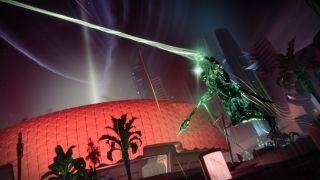
Destiny 2 players are notorious for finding ways to go out of bounds, either to cheese encounters or access secret content. Surely the addition of such a powerful movement tool will lead to an explosion in shenanigans?
"I'm always nervous when we introduce new things," says McAuliffe. "But it's nervous excitement. We want to push the boundaries of freedom and choice." He also thinks the hook has the potential to revitalise old content, because players will be able to traverse the spaces differently. On the potential for breaking the game, he's relatively relaxed. "Our test team is incredible. We will locate and fix the most egregious issues. You know there will be industrious players looking for ways to grapple over mountains, but I think that is absolutely worth the trade-off for the cool moments of feeling like a superhero when you grapple in, revive a teammate, and get the heck out of dodge."
Blackburn adds that the decision to greenlight the grappling hook was made as soon as they saw it, because it was too cool to say no to. "I don't think it's necessarily going to drastically increase the ceiling for out-of-bounds shenanigans," he says laughing, "because our ceiling is already really high." What it probably will do is make it easier for lower skilled players to visit mysterious hidden areas like the Galaxy Pools without having to learn arcane sword movement glitches.
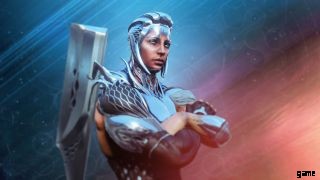
Why get cyberpunked now?
Watching the showcase, I have to say I was a little surprised at how hard Destiny 2 is leaning into the neon-drenched look. Aside from light dalliances with the cyber aesthetic during Season of the Splicer and locations like the Arcology on Titan, the Destiny series has largely stuck to its signature style of collapsed civilization overrun by nature.
I'm worried going full cyberpunk might make Neomuna seem a bit obvious . McAuliffe doesn't think so. He says one of the main reasons for the radical change of direction was the desire to create separation from The Witch Queen, which was all earth tones, flat ground, and caves. "Rather than give [players] another terrarian sort of environment, we asked what would be a really strong change of pace. Go up. Go modern. Go fabricated instead of grown."
The key idea was verticality, which led to traversal and actually entering these futuristic spaces. Neomuna is also notable for being inhabited, rather than abandoned. This is a world under invasion by Calus and his troops, with its own defence force in the form of the Cloud Striders. Contrary to what I'd assumed from the various leaks, the Cloud Striders are not aliens, but human colonists who fled the original Collapse on Earth and have since evolved in secret. They're powerful but they aren't Light wielders, and they won't be the ones to teach us the secrets of Strand. "We're finding something that has never been touched," confirms McAuliffe.
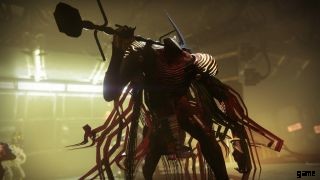
The biggest threat on Neomuna's streets comes from Tormentors, huge denizens of the pyramid ships. It's exciting that, with the current era of Destiny 2 drawing to a close, we're finally facing off against actual forces of The Witness.
"That's clearly what we're doing here with the Tormenters," says Joe. "We're showing what these disciples and followers of the pyramid look like. Some of the most ancient, most converted ones."
In terms of design, Tormentors share much DNA with Rhulk, the raid boss from Vow of the Disciple. "Rhulk was a big lift for the team," says Blackburn, "because it was the first one. We needed people to come away saying:'Whoah, these things are tough'. They could take on anything we've fought before. We want to keep that bar really high." He says Tormentors will be even more dangerous than Hive Guardians, so when one appears it's going to be a big deal.
McAuliffe agrees:"It's a thing that demands all of your attention in a solo activity, and in a group activity the callout is going to be:'Fuck, fuck, fuck, Tormentor!"
An end to sunsetting
Snuck in towards the end of last week's showcase was a piece of bookkeeping that gave relief to the whole fanbase. Bungie will no longer be 'sunsetting ' entire expansions. In 2020, due to the game's ever bloating file size, and the impossibility of testing and balancing every new piece of content against all the old stuff, the studio took a tough decision to begin removing some expansions, including their accompanying planetary destinations. Predictably, it was about as popular as taking away paid content ever is. So what changed? McAuliffe:"As we close the Light and Darkness saga, which runs from Shadowkeep to the Final Shape, we want to make sure that the whole sequence is fully playable from start to finish. That's critically important to us."
The reversal on sunsetting has been enabled by upgrades to the game engine and infrastructure. Seasonal content will continue to expire as normal, but bigger content drops like last year's 30th Anniversary DLC will stick around in perpetuity. "It's not a case of we just fixed one flaw in the engine and now never need to sunset anything ever again," cautions McAuliffe. "We're always going to be making hard trade-offs between ongoing interoperable systems and awesome content and the ever-growing file size." I ask him specifically whether some of the older planets might still be on the chopping block. "Everyone can breathe easy about Nessus," says McAullife. "At least for now."
 Dan McAuliffe
Dan McAuliffe Dan McAuliffe has been at Bungie for two years, having previously spent time at Wizards of the Coast and Amazon Game Studios. Knicks fan, for his sins.
A related perennial problem is that of item storage. Bungie gave players an additional 100 slots to store gear in The Witch Queen, and sure enough we rapidly filled those up and began complaining again. I ask Blackburn what the long term answer is, because it's not like they're going to stop making new guns every three months. "This is still on our list of big, hard Destiny problems that we want to look at," he says. "We're looking at systems that can make you feel like you don't need to keep everything, because the world doesn't end if you get rid of a gun.
"It's a really interesting problem, and I think unique to Destiny because so many other MMOs just say you can't use this gear anymore. Whereas we're on the opposite side saying:'What if you could use everything?' And players are like 'great, we love using everything!' But your house only has so much closet space."
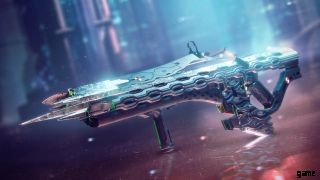
Part of the problem is that Destiny isn't like other MMOs. A sword in World Of Warcraft is basically just a stat stick, but Destiny's guns look and feel amazing, so players get emotionally attached to them. Blackburn thinks that finding new ways for players to be able to reclaim weapons and perk combinations they've acquired in the past could be part of the solution, but that becomes another data storage issue.
Hoarding is compounded by the way that the combat meta in Destiny changes so often, with whole archetypes of weapons phasing in and out of relevance according to balance changes and seasonal mod options. As a result, the community clings to several versions of every notable weapon variant in case they suddenly become relevant.
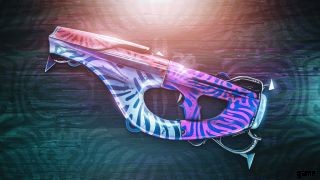
"Crafting has the potential to be a solution here," says Blackburn, "but the risk is that one false move and suddenly the whole game is unlocked at your fingertips at all times." I ask him whether it might help if crafted weapons let you create an extra row of perks once you got to a certain level, negating the need to keep multiple versions of the same gun for separate purposes (eg, a PvE and a PvP Austringer).
Blackburn doesn't promise anything, but he does like the fact that having a crafting pattern unlocked means you can adapt to the meta as it shifts, alleviating some pressure on players' vaults. However, he also admits:"The thing that we haven't solved is the player that wants to swap quickly between two different perk options."
Playlist activity and subclass refresh thoughts
Towards the end of our talk, I turn to one of the topics that bother my clanmates most:The lack of updates to the Vanguard Strikes, Crucible and Gambit playlists. For a long time these were core to the Destiny 2 experience, with players grinding out rewards and XP over endless matches and missions. These days, with some of the content in terms of maps and missions lost to sunsetting, and other stuff five years old and showing it, over-familiarity can make these playlists very frustrating to feel forced to engage with.
"We have a team that's looking at a bunch of these problems and I'm really even happy with the work that we've seen this year with us doing things, like adding Battlegrounds, to those playlists," says Blackburn. "We're going to be doing a bunch of work specifically in the Vanguard [playlist] around Lightfall. We're going back to some Strikes to update them." McAuliffe adds that he doesn't think every Strike needs to be replaced, but says the team wants to go into the older ones and give them the same kind of attention that new content gets.
I have to imagine that Bungie's to-do list for Destiny 2 is voluminous at all times. The studio is essentially engaged in an eternal process of rebuilding the airliner as it flies it. Over the past three seasons the heaviest lift has been the rework of all three original Light subclasses in order to move them onto the modular system that Stasis uses. The result has seen an explosion in power level as new synergies and combos were created. In some cases, whole new abilities were added, while old favourites got revamped. Many perks were rolled into each other, while others were removed entirely, and for the most part the response has been positive. Certainly, our guardians have never felt so strong.
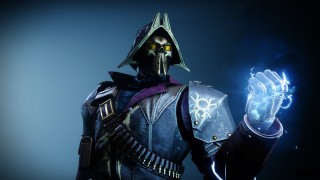
Inevitably, with such a large playerbase, there has also been criticism. The rework to Void Hunters and Solar Warlocks seemed to miss the mark, although in both cases experimentation has led to powerful builds. I ask if it's disappointing when groupthink sets in after only a few hours of play. "No," says McAuliffe.
"If everyone universally hated all of the 3.0 updates I would be disappointed, because of all the work that goes into them" he says. "I think, much like most of social media, if you want to find a particular echo chamber you can find it, but what we're seeing from the community is diversity of thought. We make such unique player fantasies that we're not going to hit everybody with every single one, and I think that's okay. So I don't worry so much about the calcification of negative sentiment from certain folks."
One of my favourite parts of these reworks has been the use of new "verbs" to denote specific effects that are shared between the perks and abilities of each subclass. Void got stuff like "Volatile" and "Weaken", Solar got "Scorch" and "Ignite", and Arc just added "Jolt" and "Amplified". My only complaint is that some of these are more visually legible than others, particularly when you're being shot at by many aliens. For example, it's easy to see that a target is Volatile, because it's surrounded by a swirl of purple particles. However, I found the solar stuff harder to parse. I can tell that a target has been Scorched because it will be burning, but it's tricky to see how much more Scorch I need to apply before it Ignites like a mini Krakatoa.
"It's something we always think about," says Blackburn. "With the older subclasses, some are easier to identify and some are hard. We have so much stuff that catches on fire! So this is a thing where, after all the subclass 3.0 work, the team is having to go back and make these elements, these buffs and debuffs, more consistent. In the future, because they've gone through this pain, they can say, 'Okay, we've got a new damage type, what's really important? What are the things we need for the visual identity?' With the newer subclasses, like Stasis and Strand, it's pretty easy to tell if something is frozen with Stasis."
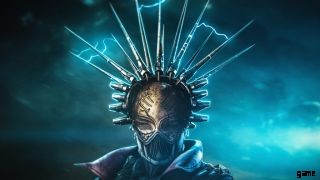
One piece of feedback I've seen regarding the recent Arc 3.0 rework is that a couple of the subclasses crutch too hard on specific exotic armor in order to make them viable. I mention Geomag Stabilizers on Stormcaller Warlock and Cuirass of the Falling Star for Striker Titans.
"I think there's a balancing point with a bunch of those," says Blackburn. "There was a long time where people that used Celestial Nighthawk were like:'This is the way you play this class, if you aren't using that why are you even using Golden Gun?' We've gotten to a place, in recent years, where we have exotics that are like a 30% boost and you can choose to run it or not to run it. It takes some time and some thought for people to break out of the idea that the only way to play Destiny is to smash the boss as hard as possible."
It's a good point and reminds of the fact that the weapon perk discourse revolves around what does the most damage to bosses in a short window of time, rather than what's useful over the entire course of an activity. Blackburn uses the example of exotic primary weapons, which were all given a whopping 40% damage buff against minor enemies, and now make power ammo drop more often, as an example of how hard it can be to change mindsets. (Hint:exotic primaries are really good .)
McAuliffe says the situation should improve once Lightfall lands. "I think that when our loadout manager comes online, it will help with some of that. Right now, I'm less likely to experiment as a player and I'll trend towards the thing that everyone says is good. Whereas if I can switch really quickly, I'm more likely to experiment and find something that works better for me."
He's right, and for an inveterate addict like me, the loadout manager is even more exciting than the addition of Tormentors. But before Lightfall arrives I still have the current Season of Plunder to yo ho my way through, and another dungeon to best before the year ends. At one point in our chat Blackburn mentions the next 10 years of Destiny, and for almost any other game that would sound absurd. But if anything, the series is only speeding up. Heading out towards the true MMO-FPS hybrid that us holdouts have been dreaming of for all these years.
